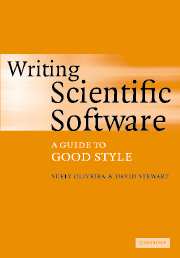Preface
Published online by Cambridge University Press: 28 January 2010
Summary
Mathematical algorithms, though usually invisible, are all around us. The microcomputer in your car controlling the fuel ignition uses a control algorithm embodying mathematical theories of dynamical systems; a Web search engine might use large-scale matrix computations; a “smart map” using a Global Positioning System to tell where you are and the best way to get home embodies numerous numerical and non-numerical algorithms; the design of modern aircraft involves simulating the aerodynamic and structural characteristics on powerful computers including supercomputers.
Behind these applications is software that does numerical computations. Often it is called scientific software, or engineering software; this software uses finite-precision floating-point (and occasionally fixed-point) numbers to represent continuous quantities.
If you are involved in writing software that does numerical computations, this book is for you. In it we try to provide tools for writing effective and efficient numerical software. If you are a numerical analyst, this book may open your eyes to software issues and techniques that are new to you. If you are a programmer, this book will explain pitfalls to avoid with floating-point arithmetic and how to get good performance without losing modern design techniques (or programming in Fortran 66). People in other areas with computing projects that involve significant numerical computation can find a bounty of useful information and techniques in this book.
But this is not a book of numerical recipes, or even a textbook for numerical analysis (numerical analysis being the study of mathematical algorithms and their behavior with finite precision floating-point arithmetic or other sources of computational errors). Nor is it a handbook on software development. It is about the development of a particular kind of software: numerical software.
- Type
- Chapter
- Information
- Writing Scientific SoftwareA Guide to Good Style, pp. ix - xiiPublisher: Cambridge University PressPrint publication year: 2006

